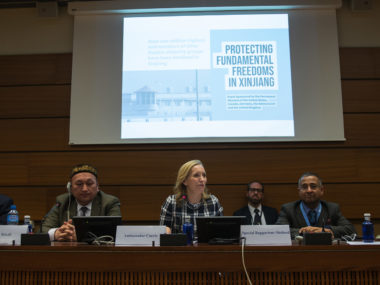
Why would anyone want to read another analysis of the commitment problems lurking in the structural framework of the 1993 Declaration of Principles on Interim Self Government (aka the Oslo Accords)? Aren’t two decades of broken promises and spasms of violence enough to accept that the parties just aren’t all that committed to peace?
Suspend well-founded cynicism and consider that the parties were committed to the bargain signed twenty years ago last week and were fully prepared to make hard compromises as long as they had credible assurances their counterpart was willing to do the same.
If the parties were in fact committed to peace, then the explanation for the dismal state of affairs today must be found in the structures designed to provide the mutual reassurances this commitment was both sustained and shared.
At first glance, Oslo’s formula looks like a classic, iterated assurance game; credibility is signaled through incremental concessions that reassure and reward: the PLO commits to end violence, Israel accepts the PLO as the sole negotiating partner; Israelis withdraw from Jericho and the Gaza Strip and the PLO comes in and maintains public order; PLO has elections and creates Palestinian Authority, Israel transfers civil authority, parties negotiate next round of withdrawals… Add burgeoning trust and repeat until a final status deal is made.
Nevertheless, the process stalled right out of the starting gate. Even before the advent of suicide bombers and the assassination of Rabin, the mutual recriminations and acrimonious haggling over which concessions hadn’t been fulfilled were so bad that the US and Egypt flew in to force the process to get on to the next stage. And that was just to get a deal on Jericho and the Gaza Strip!
Although the process produced a steady stream of interim agreements, elections and limited redeployments, distrust grew with each successive round. Why? Because Oslo’s scheme of incremental measures were set up to encourage delay, reinforce self-help and therefore fomented mistrust.
The ample literature on this topic has consistently demonstrated that successful peace bind the parties into mutually restraining, self-reinforcing power sharing pacts. Signals that are most credible are those that limit the ability of either party to enhance their position vis-à-vis their rival. Under the Oslo formula, the limitations on self-help were asymmetric, the assumption of risk contingent and qualified and the end game undefined. This structure had the inverse effect of mutually restraining pacts in that the signals transmitted were of prevarication, foot-dragging, constant reinterpretation and mistrust. They also left the whole process hostage to spoiler violence.
Looking at the process as a sequential game, the root of these confused signals appears. First, the subordinate player makes the first move with a fairly unconditional limitation on future action; no more terror or violence and a commitment to discipline violators. This was a heavy-duty signal, it was difficult to carry out (the Israelis had been unsuccessful for the previous 25 years) and handed veto power to spoilers by rendering any act of violence a referendum on the credibility of the PLO.
Moreover, like any sequential game Israel’s next moves calibrated on the first. As spelled out in Article XIII: “redeployments will be gradually implemented commensurate with the assumption of responsibility for public order and internal security by the Palestinian police force.” Thus, any act of spoiler violence provoked vociferous cries from the Israeli opposition to “slow-down.” Yet when they did, Palestinians lost trust.
Making matters worse, the provisions for Israel to responsibility for overall security outlined in Article VIII, which were intended to reassure Israelis on the risks of withdrawal, bound Rabin and subsequent Israeli prime ministers to take strong measures, like closures on Palestinian areas, stringent security checks, sharp limitations in imports and exports and laying down security by-pass roads deep in the heart of the West Bank in response to acts of spoiler violence. These measures made perfect sense in reassuring the Israeli public that their government was credible on their defense, but it undermined Palestinian faith that the process was heading toward self-determination.
Let me be clear. I am not saying the agreement was unfair. It was negotiated and accepted by both parties without coercion. It also made perfect sense in terms of the perception of risks Israel felt it was taking; risks which are very real. I am just saying that inoculating yourself from risk and keeping your options open may, however vital for self-defense and domestic politics, compromise signals of a credible intent. Especially when spoilers abound.
This cycle of spoiler violence, delays and rescaling commitments can be traced through the first four rounds of interim agreements and right up through Oslo’s collapse in July 2000. And despite changes in leadership and huge progress towards defining the scope of a final deal, this formula remains constant in every initiative since. It is in the Clinton parameters, the Bush road map and explicitly spelled out in the policy speech Obama made in 2011. It is almost certainly underlining this current round of talks, in which deep distrust is apparently a significant issue.
Overcoming the credibility problem is essential for any deal to succeed. To expect that Israel will hand over territory without credible assurances for its security is certainly insane. Yet so is applying the same security formula again and again, and each time expecting different results.
During the talks in Oslo so very long ago, the PLO suggested international peace-keepers — AKA third party security guarantors — to back up the process. Both parties were cognizant that violence would be a problem. But the Israeli team demurred, not wanting to sub-contract their security to outsiders or let responsibility for violence get lost by introducing a third party to parse out the blame. While this is an unquestioned right of sovereignty, the viability of a peace process without such measures has proven very questionable.








1 comment
While this is an accurate depiction of how the peace process stalled, the author like so many before her, largely misses the problem.
This is *not* a two player game with “spoilers abound.” The issue of an Israeli-Palestinian peace settlement is at least a 3 player game, which is not modeled–let us assume the PLO can control its own subgroups.
The author does not once mention the third player, the second largest Palestinian political party, Hamas.
While Hamas acted as a spoiler in 1993 (because it was anti-settlement, *and* because it was excluded from negotiations) it has since claimed it would participate in final status negotiations–Yassin did this before his assassination; and Mashal seems open to the idea as well. More importantly, Hamas is a democratically elected political party, a party that won the last openly contested legislative elections in the Occupied Territories, a party that governs the Gaza Strip.
To think of Oslo as a commitment problem is to fundamentally misunderstand the issue. There were players that went unaccounted for in the negotiations, they never made any commitments, and thus were free to act of their own accord. To have a commitment problem all key parties must have committed to an issue, but this is not the case for Oslo.
Any revived discussion of Israeli-Palestinian peace *must* therefore now be a 3 player game; and discussion on how think about future status negotiations must account for Hamas.